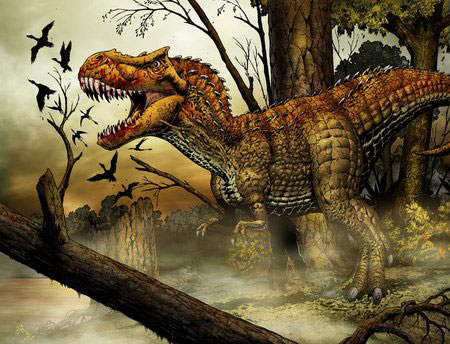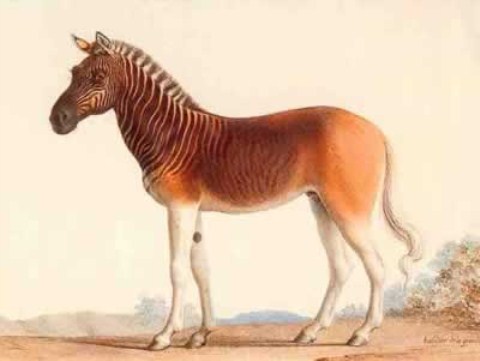10 strange extinct animals
The extinct animals on the Earth, such as the giant tyrant dinosaur, the dodo bird or the half-zebra species . contain many strange things.
Emperor tyrant dinosaur (extinct 65 million years ago)

The tyrannical dinosaur has a huge size.
The tyrant dinosaur is one of the largest land-based predators of all time. They have a body length of 13m and a height of 5m, and a weight of up to 7 tons.
Like other carnivores, tyrant dinosaurs walk with two legs, with a very heavy head to balance with a long and heavy tail. In contrast to the two large and powerful limbs, their forelimbs are small and only two burn.
The tyrannical dinosaur fossil was found in the North American rocky area, dating to the Cretaceous Cretaceous, about 68 to 65 million years ago.
They are one of the last surviving dinosaurs after the mass extinction event of this species. There are more than 30 species of imperial tyrants dinosaurs identified. With a large number of species of fossils, scientists can find many of their biological signs, including life and habits.
Quagga zebra: half a zebra, half a normal horse (extinct in 1883)

The special zebra quagga: half body on zebra-like, lower half resembling ordinary horses
One of Africa's most famous extinct animals, the Quagga is a subspecies of the delta zebra, once inhabited in large colonies in the Cape and Orange Free states, South Africa.
They are different from other zebras because the back is normally brown, without a mark, and the middle is dark. Their names are derived from Khoikhoi's monumental words, expressing the cries of this species.
The quagga zebra has only been classified as an ordinary zebra species in 1788. Being hunted for meat, skinned and traded, they become extinct, with the last wild quagga being seen. 1870s.
Mammal in Tasmanian: Tasmanian Tiger (extinct in 1936)

The Tasmanian tiger has striped stripes on its back.
They are the largest carnivorous mammals in the modern world. A native of Australia and New Guinea, this marsupial is extinct in the 20th century. They are often called tasmanian tigers because their backs are brown stripes.
This marsupial mammal was extinct in Australia for thousands of years before Europeans landed here, but there is still one endemic species on the Tasmanian island, the Tasmanian devil.
Excessive hunting as well as human invasion, plus new dogs appear to be the cause of the Tasmanian tiger extinction.
Steller dug (extinct in 1768)

Steller dug has a thick, black skin like an old oak tree.
This marine cow was discovered by naturalist Georg Steller during his Bering expedition.
They are about 7.9m long, weigh about 3 tons, much larger than manatees. They are like a large seal, with two rowing fins and tails like whales.
Steller recounts: "This animal never comes near the coast, always lives in the water. Their skin is black and very thick, looking like an ancient oak tree. Their heads are quite small compared to the body, no teeth that only have two flat white bones above and below. They are completely harmless. "
Their fossils indicate that this sea cow usually lives along the Arctic Ocean coast, to the south of Japan and California.
The extinction of this species is caused by an increase in the population around the area, they are hunted too easily because there is no defense.
Today, there are still unclear reports about the observation of an animal that closely resembles this dugong in the Bering and Greenland Islands. Perhaps a small group of this species still exists today.
Irish deer (extinct 7,700 years ago)

Giant deer have antlers up to 4m long and weigh about 40kg.
This giant Irish deer is the largest deer ever living on earth. They live scattered from Ireland to the east of Lake Baikal, in the late Pleistocene and early Holocene.
By carbon analysis method, scientists determined the last trace of this species of deer is about 5,700 to 7,700 years BC.
The deer is 2.1 m tall, with the most massive antlers: about 3.65 m long and weighs 40 kg.
The extinction of this giant deer still focuses on their giant cage antlers. It makes the males restricted to moving through the forests, inferior to the elk here. Another hypothesis is due to excessive hunting of this species.
Caspian tiger

Caspian tigers have fur on their cheeks like a beard.
The Caspian tiger, also known as the Persian tiger, is a sub-species of tiger, often living in Iran, Iraq, Turkey, Mongolia, Kazaghtanm, Caucasus, Tajikistan, Turmenistan and Uzbekistan, until they are exhausted. strains in the 1970s.
The Caspian tiger body is strong and long, with strong legs, huge claws. The ears are short and small. The special thing is that their cheeks are covered with long, bearded hair. Their color is like the Bengal tiger. Males are very large, weighing 140 to 240 kg, females are smaller, only about 85-135 kg.
European bison (extinct in 1627)

European bison.
They are one of the most famous extinct animals in Europe. Originating from India, about 2 million years ago, this species immigrated to the Middle East and Asia, eventually to Europe about 250,000 years ago.
In the 13th century, the bison was only found in Poland, Lithuania, Moldavia, Transyvania. Only nobles and royalty have the right to hunt this species.
The number of species rapidly declined, and the bison eventually ended life in 1627 in Poland. Its skull was occupied by the Swedish army and the property of Stockholm.
In 1920, two German zookeepers, brothers Heinz and Lutz Heck, attempted to cultivate this species of bison from their domestic cows as their descendants. Their plan is based on the concept that a species is not extinct when its genes are still present in descendants.
The result is a breed of cattle called Heck (regenerated species of European bison). However, it is not exactly the same as their ancestors.
Giant anca bird (extinct in 1844)

Anca birds are almost like penguins
The giant anca bird that lives in the Atlantic Ocean cannot fly. They are about 75 cm tall, weigh about 5 kg, are the largest anca bird in their family. They have black back and white belly.
Traces show that they once lived in huge swarms in Canada, Greenland, Iceland, Norway, Ireland, the United Kingdom.
Hunting is also the cause of this species extinction.
Cave lions (extinct 2,000 years ago)

The cave lion species lives in Europe.
The cave lion species, also known as the European cave lion is a sub-species of lion, extinct about 2,000 years ago. Today, people only know this species through fossils and prehistoric paintings. They are described with a height of about 1.2 m, 2.1 m long in the tail, almost like modern lions.
Dodo birds

Dodo birds are extinct because they are easy to hunt
This is a bird that cannot fly, lives on the island of Mauritius. There are relatives with pigeons, they are about 1 meter tall, live and feed in the underground nest.
This bird became extinct from the second half of the 17th century. The extinction of this bird was due to the hunting of human beings, also forming idioms such as "Dead like dodo" means death clearly, nothing to think, or "follow Dodo's path" means to enter the dead path, becoming a past.
- Mammoths and extinct animals are about to be revived
- Development technology revives extinct species?
- Regenerating extinct animals
- 10 animals make humans extinct if revived
- The evolution of animals does not keep pace with extinction
- The reasons for extinction of animals are more difficult than we imagined
- Extinct animals have the opportunity to
- Tail pieces can help revitalize extinct bison 12,000 years
- Video: Discovering the strange giant salamander in Japan
- Discovered that white-edged pheasant is considered extinct
- Extinct animals are forgotten by humans
- 95% of lemurs are about to become extinct. What is happening?
 Animal 'suffering' after hibernation
Animal 'suffering' after hibernation Why do goats climb well?
Why do goats climb well? Scientists were surprised to see chimpanzees eating turtles
Scientists were surprised to see chimpanzees eating turtles Giant catfish died deadly due to drought in Thailand
Giant catfish died deadly due to drought in Thailand